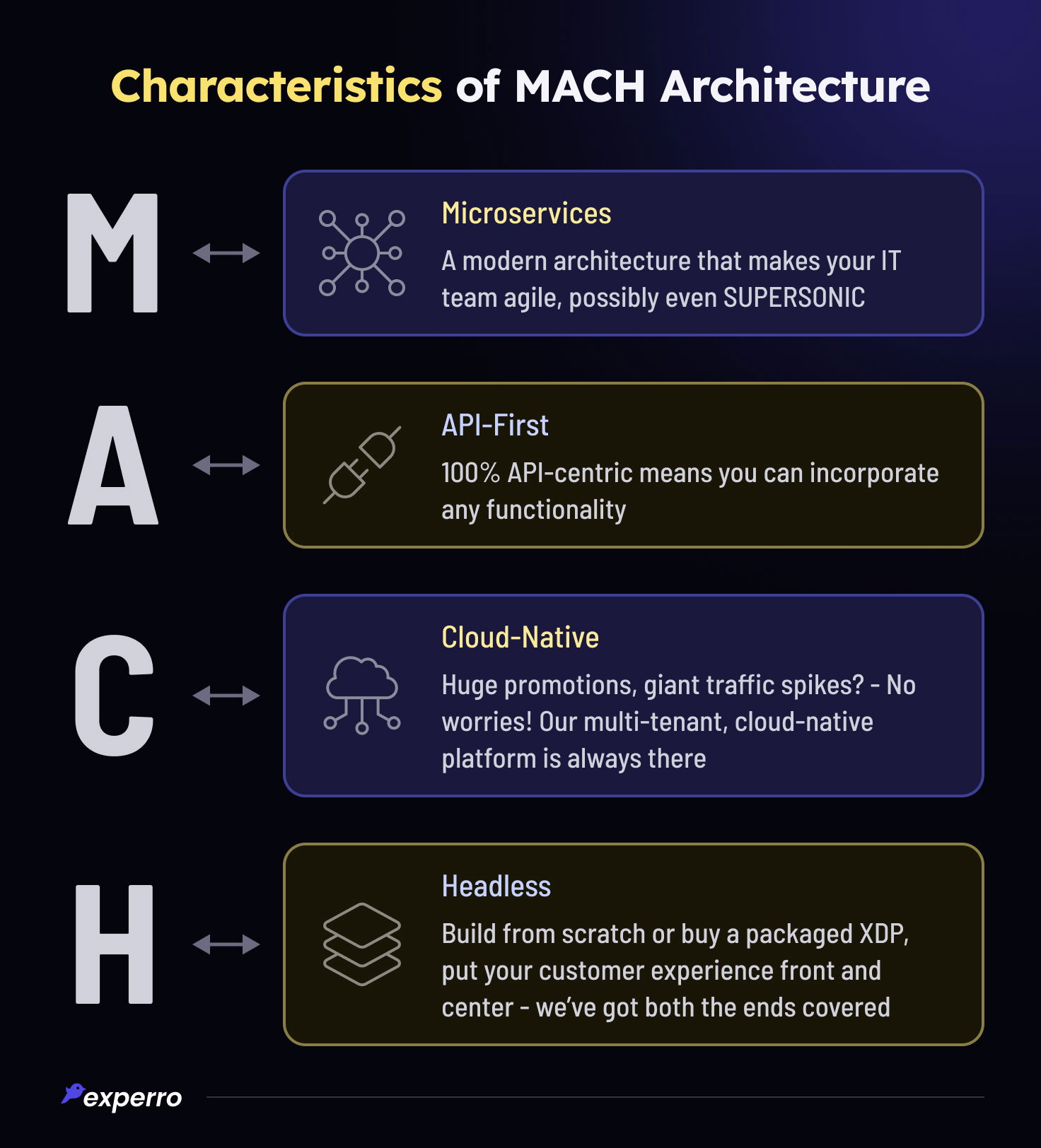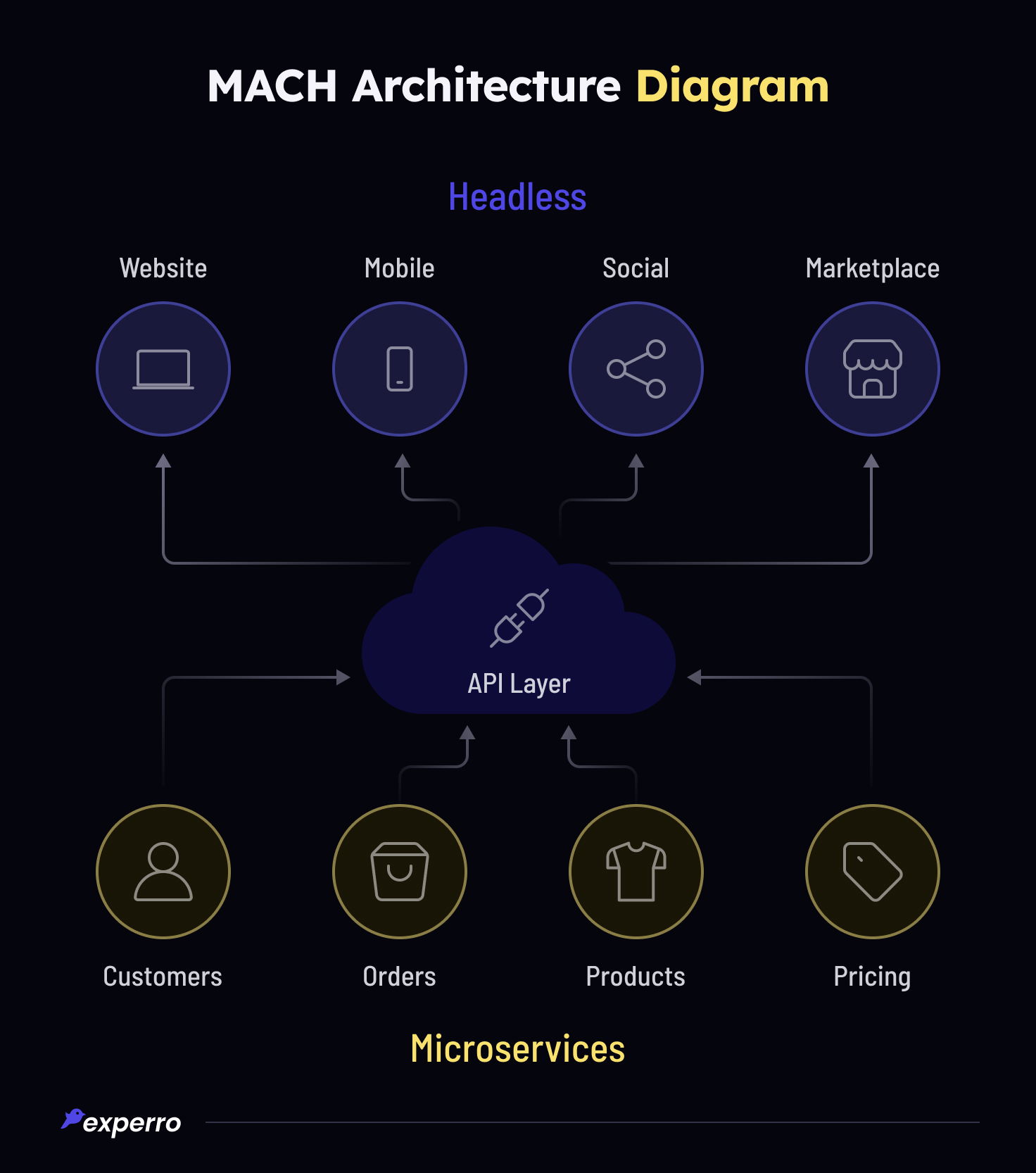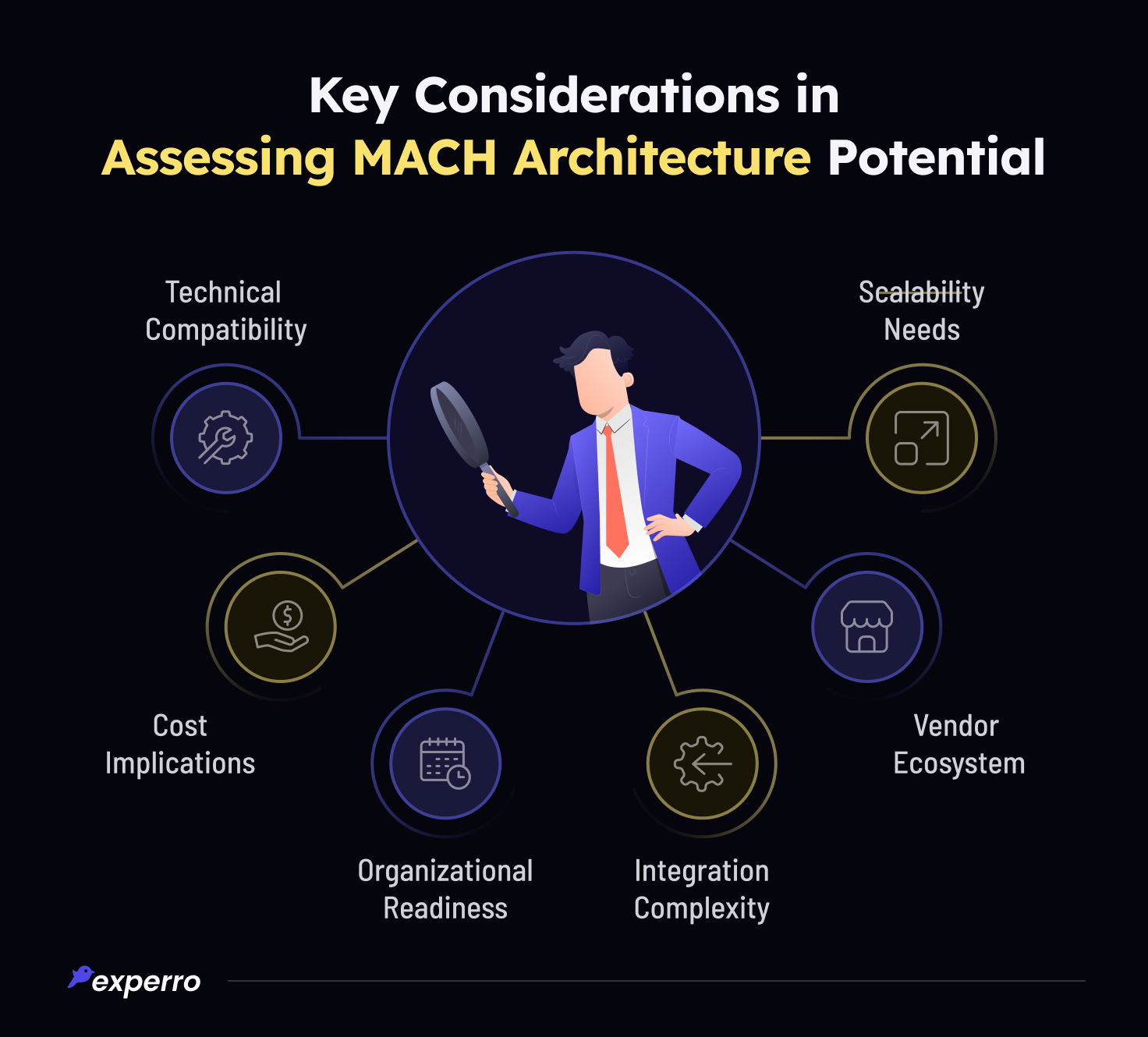What Is MACH Architecture? Structure, Comparison and More!

What’s Inside
- What is MACH Architecture?
- Definition of MACH Technology
- MACH Architecture Diagram
- Factors to Consider When Evaluating Potential MACH Architecture
- MACH Software Architecture
- MACH Architecture Examples
- MACH Architecture Gartner
- Looking for a Headless CMS with the most robust architecture?
- Table of Comparison - Monolith vs. MACH
- Table of Comparison - MACH Architecture vs. Microservices
- Experro Follows MACH Architecture
- Want to understand more about our product and its compatibility with MACH?
- Conclusion
Key Takeaways
- MACH architecture is reshaping the digital landscape and becoming the benchmark for future software development.
- Adhering to principles such as microservices, API, cloud-native, and headless architecture, MACH offers flexibility, scalability, and improved user experiences.
- Evaluating a transition to MACH requires a comprehensive understanding of the technology stack, costs, organizational readiness, and the vendor ecosystem.
With an increase in the number of digital services, the frameworks and architectures previously in play began to show limitations, especially in catering to today's customer expectations.
Amidst all this, the need for more adaptable software architecture became paramount.
Considering these challenges, the MACH technology approach emerged, promising infinite scalability and a framework-agnostic technology structure.
MACH architecture caters exceptionally well to today's software requirements, focusing on modularity and adaptability.
Before diving into MACH, do you want to understand what headless CMS is and how it works? Dive into our insightful guide!
What is MACH Architecture?
MACH (Microservices, API-first, Cloud-native, and Headless architecture) is a novel design paradigm tailored for today's software and eCommerce store development needs, leveraging the best-of-breed approach in technology.
Definition of MACH Technology
MACH architecture is a modern, modular design approach for building digital platforms using microservices-based architecture, API-first methodologies, cloud technologies, and a headless CMS approach.
This structure ensures that software applications are flexibly adapted, scaled independently, and remain future proof amidst changing customer behavior and business requirements.
M.A.C.H. Core Characteristics

- Microservices: Unlike monolithic designs where the entire system operates as one unit, MACH technology utilizes independent services, each performing a single function. These services communicate via APIs, ensuring loose coupling and facilitating continuous delivery.
- API-first: In a MACH approach, the API-first strategy ensures seamless integration with other components and systems. This makes it easier for development teams to create, test, and deploy individual components, speeding up time to market.
- Cloud-native: MACH architectures are explicitly designed for cloud infrastructure, leading to cloud-native apps that benefit from automatic upgrades and scalability.
- Headless: In the realm of MACH, headless architecture decouples the presentation layer from the back-end logic, enabling organizations to create decoupled frontend experiences tailored to customer needs. This ensures that while the backend manages business functionality, the frontend can be designed specifically for varying customer experiences across different channels.
How these Principles Interplay in Agile Development
Interweaving these principles results in a holistic MACH approach, offering businesses a tech stack that's flexible, scalable, and efficient.
This synergy ensures that software remains agile, allowing for quick adaptation to new trends while keeping the customer experience at its heart.
In fact, 79% people in a survey showed the eagerness to increase MACH investments in the architecture in the future.
MACH Architecture Diagram
So, here’s how the MACH architecture looks like:

Visual Representation
A MACH architecture diagram showcases how the best-of-breed technologies are intricately woven together, highlighting the synergy between microservices, API-first approaches, cloud-native infrastructures, and headless commerce. It provides a detailed representation of how these components communicate, ensuring modular design and seamless interaction.
Explanation of the Diagram
Symbols typically represent each component, with arrows or lines indicating communication and interaction pathways.
The MACH approach diagram often showcases independent services and how they contribute to an integrated, holistic system, emphasizing the composable architecture's strengths and future-proof characteristics.
Factors to Consider When Evaluating Potential MACH Architecture

Embracing MACH architecture is a pivotal decision, bound to impact a company’s digital transformation journey. When evaluating the potential of MACH for your operations, several vital factors need thorough consideration.
Technical Compatibility
Before embarking on the MACH approach, it's essential to assess the current technology stack. Understanding whether your existing solutions are loosely coupled or if they can easily integrate with MACH components is critical.
Businesses should be wary of potential technology replacements, ensuring that re-deploying solutions doesn't disrupt business functionality.
Organizational Readiness
A switch to MACH requires development teams that are familiar with agile development processes and emerging technologies in the MACH landscape.
It's essential to understand the skill level present within your organization, ensuring a smooth transition. Training might be necessary, particularly to acquaint teams with the specifics of composable commerce and best technologies.
Cost Implications
While MACH might involve an initial investment, the long-term benefits often outweigh these costs. From automatic upgrades to the reduced need for legacy infrastructure maintenance, MACH offers efficiency.
However, it's imperative to measure these advantages against potential short-term expenses, ensuring a balanced financial strategy.
Scalability Needs
MACH's architecture, being cloud-native, inherently provides infinite scalability. It’s important to align this with your organization's growth projections.
Given the loosely coupled nature of its components, businesses can scale their operations based on specific requirements without overhauling the entire system.
Integration Complexity
For businesses with numerous existing integrations, the transition to MACH might be complex. It's crucial to gauge how the new architecture will interact with other components in your tech stack.
The best approach, however, allows for tailored integrations, ensuring that the business's unique needs are met.
Vendor Ecosystem
The MACH alliance has several reputable vendors that offer tailored solutions. When considering MACH, it's essential to explore these vendors, understanding their reliability, support structures, and how they can cater to your specific business needs.
MACH Software Architecture
In the heart of the digital revolution, software architecture is evolving to cater to customer expectations better, with MACH technologies leading the charge.
Role of MACH in Software Development & Design
Incorporating the MACH principles into software design ensures a modular design and best in class methodologies.
With each component designed specifically for its function, the software remains loosely coupled, facilitating seamless upgrades and infinite scalability.
By focusing on independent services, organizations can better tailor their platforms to specific business needs.
How it Aligns with Modern Software Requirements
Modern businesses require agility, scalability, and a focus on customer experience. The MACH approach, with its emphasis on agile development practices, cloud-native SaaS models, and headless commerce, meets these needs head-on.
By leveraging best-of-breed technologies and adopting a composable architecture, MACH platforms are future-proof, scalable, and designed with customer behavior at the forefront.
MACH Architecture Examples
Let's take a look at a few examples of MACH Architecture and its implementation to help you get a better understanding:
Real-world Implementations
Companies globally have embraced MACH's principles, from cloud-native apps ensuring quick time to market to modular design allowing businesses to stay ahead of customer behavior trends. Success stories often highlight seamless upgrades, increased flexibility, and heightened responsiveness.
MACH Architecture in Commerce
The realm of eCommerce has greatly benefited from MACH. Composable commerce platforms leveraging MACH's principles allow businesses to customize their offerings, providing unique customer experiences.
This framework agnostic technology structure ensures businesses aren't confined, enabling them to keep up with evolving digital services.
MACH Architecture Headless Examples
The headless approach, a core tenet of MACH, has been transformative for many sectors.
By decoupling the frontend, companies can tailor their presentation layers across varied channels, ensuring consistent and tailored customer experiences.
This flexibility, combined with the API-first approach, empowers businesses to evolve their digital services rapidly.
MACH Software and Technologies
There's a plethora of MACH software available, each designed specifically to enhance business functionality in unique ways.
From tools promoting composable architecture to platforms focusing on headless commerce, the MACH technologies landscape is vast and evolving.
Leveraging these tools ensures businesses remain future proof, catering to ever-evolving customer expectations.
MACH Architecture Gartner
Gartner, a renowned research firm, has emphasized MACH's significance in several of its findings.
With a focus on the future of software architecture, Gartner's perspective on MACH is that of a transformative framework that aligns with the needs of modern businesses.
Their research often underscores the benefits of MACH architecture, especially its ability to cater to evolving customer needs swiftly and effectively.
Table of Comparison - Monolith vs. MACH
Feature/Aspect | Monolithic Architecture | MACH Architecture |
|---|---|---|
| Design Philosophy | Unified & Interdependent | Modular & Independent |
| Scalability | Limited; often requires the entire system to scale | Highly scalable; components can be scaled independently |
| Flexibility | Rigid; changes can affect the entire system | High; components can be changed or replaced without major disruptions |
| Integration | Can be challenging due to tight coupling | Seamless; thanks to the API-first approach |
| Deployment | All-or-nothing deployments; changes often require redeploying the entire system | Continuous delivery; components can be deployed independently |
| Tech Stack | Often restricted due to legacy infrastructure | Tech stack is flexible, leveraging best of breed technologies |
| Response to New Trends | Slower adoption due to tight integration | Agile development ensures quick adoption and integration of new trends |
| System Overhead | Less overhead initially; can be cumbersome as it grows | Overhead for setting up, but proves efficient in the long run for large-scale applications |
| Cost Implication (Short Term) | Often cheaper initially | Might require more initial investment due to its modular design |
| Cost Implication (Long Term) | Can become expensive due to refactoring and scalability issues | Long-term benefits in cost due to scalability and flexibility |
| Development Approach | Traditional software development | Future proof, emphasizing emerging technologies like cloud-native apps |
| Customer Experience | Can be limited due to rigid backend logic | Enhanced due to headless approach allowing bespoke frontend experiences |
Definition of Monolith Architecture: A monolithic architecture is a software design where different components (like data input and output, data processing, error handling) are interconnected and interdependent, as opposed to being split into microservices.
Differences and similarities: While both systems aim to serve business needs efficiently, the key distinction lies in their agility and scalability. MACH, with its loose coupling, offers businesses flexibility monoliths often can't, especially when it comes to integrating new trends and technologies. However, monoliths can be advantageous for smaller projects where the overhead of MACH may not be necessary.
Pros and cons of both architectures: MACH excels in scalability, flexibility, and future-proofing a business. Monoliths, while less flexible, offer simplicity, which can be advantageous in specific scenarios.
Table of Comparison - MACH Architecture vs. Microservices
Feature/Aspect | MACH Architecture | Microservices |
|---|---|---|
| Definition/Scope | An overarching architectural approach embracing Microservices, API-first, Cloud-native, and Headless. | A specific architectural style where applications are composed of small, independent services. |
| Components/Elements | Emphasizes separate components like APIs, cloud technologies, headless architecture decouples, and more. | Focuses on independent services that run specific business functions. |
| Scalability | Infinite scalability, as each component (like cloud-native apps) can scale independently. | Highly scalable, as each microservice can be scaled on its own. |
| Integration | Made easier by the API-first approach, which encourages integration with other components. | Typically built for integration using lightweight protocols, but requires well-defined interfaces. |
| Flexibility | Extremely flexible, allowing for the decoupled frontend and modular design. | Flexible in terms of service development and deployment but may have limits in overarching design. |
| Tech Stack Diversity | Framework agnostic technology structure allows for diverse technology stacks for different components. | Each service can use a tech stack best suited for its function, resulting in potential tech stack diversity. |
| Development Approach | Prioritizes agile development to quickly adapt to new trends and customer needs. | Emphasizes decoupling and modular development, typically within an agile framework. |
| System Overhead | Can have an overhead due to managing multiple components and services. | Requires overhead in terms of network calls and managing inter-service communication. |
| Deployment | Continuous delivery enabled, with each component (like cloud native SaaS) deployable independently. | Services are deployed independently, supporting continuous delivery. |
| Cost Implication | Initial investment might be higher due to comprehensive architecture, but offers long-term benefits. | Initial setup can be costly, especially when decoupling from monolithic. However, maintenance and scalability can be cost-effective in the long run. |
| Customer Experience | Enhanced by the headless approach, giving developers freedom to craft bespoke frontend experiences. | Primarily backend-focused; impact on customer experience depends on frontend implementation. |
| Design for Future Trends | Designed specifically to be future-proof, embracing emerging technologies. | Can adopt new features or technologies by updating or adding services. |
| Primary Focus | A holistic approach encompassing various facets of modern software architecture, prioritizing customer experience. | Focused on the backend and service architecture, enabling modularity and independence. |
Highlighting the relationship between MACH and Microservices: While microservices form the "M" in MACH, the other principles enhance and expand on this foundation, ensuring that businesses benefit from a comprehensive, future-oriented framework.
Pointers on how MACH expands on the Microservices concept: MACH integrates cloud technologies, an API-first approach, and the decoupled frontend (headless) to offer an architecture that isn't just about service segmentation, but also about integration, scalability, and performance across all digital services.
Experro Follows MACH Architecture

You can take our word for it!
- Experro employs a microservices architecture, ensuring that each aspect of the platform—from content creation to delivery—is modular and independent.
- Experro allows businesses to adapt and connect with a myriad of tools and platforms effortlessly, amplifying their digital potential.
- Born and bred for the cloud, Experro showcases unmatched flexibility and scalability. This cloud-native commitment ensures that Experro can gracefully manage ever-changing demands—be it a surge in user traffic or escalating storage requisites.
- Embracing the headless paradigm, Experro separates its back-end functionalities from the front-end display.
Conclusion
MACH architecture has emerged as a transformative force in software and eCommerce store development, enabling businesses to adapt, innovate, and scale in today's dynamic digital landscape.
Stay tuned to know more!
FAQs


Mehul Shah
21 June 2024A digital marketer with an uncommon funny bone and a knack for perfection, Mehul has been writing about how going headless can help eCommerce stores & businesses for quite some time now! He is a digital marketer and a geek in Inbound marketing who likes to spend most of his time researching ways technology influences your daily life (positively).